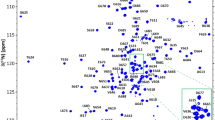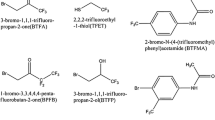Abstract
The backbone 1H, 13C and 15N resonance assignment of Ubiquitin Specific Protease 7 catalytic domain (residues 208–554) was performed in its complex with a small molecule ligand and in its apo form as a reference. The amide 1H-15N signal intensities were boosted by an amide hydrogen exchange protocol, where expressed 2H, 13C, 15N-labeled protein was unfolded and re-folded to ensure exchange of amide deuterons to protons. The resonance assignments were used to determine chemical shift perturbations on ligand binding, which are consistent with the binding site observed by crystallography.








Similar content being viewed by others
Data availability
The backbone 1H, 13C and 15N resonance assignment of apo Ubiquitin Specific Protease 7 catalytic domain (residues 208–554) was deposited in Biological Magnetic Resonance Bank under accession code 51912. The assignment for the complex with compound 21 (O’Dowd et al. 2018a) was deposited under code 51913.
References
Ashton NW, Valles GJ, Jaiswal N, Bezsonova I, Woodgate R (2021) DNA polymerase iota interacts with both the TRAF-like and UBL1-2 domains of USP7. J Mol Biol 433(2):166733. https://doi.org/10.1016/j.jmb.2020.166733
Bezsonova I, Avvakumov G, Dhe-Paganon S, Arrowsmith CH (2010) Solution NMR structure of human ubiquitin specific protease Usp7 UBL domain (residues 537-664). NESG target hr4395c/ SGC-Toronto. Biological Magnetic Resonance Data Bank deposition code 16789. https://bmrb.io/data_library/summary/index.php?bmrbId=16789
Bezsonova I, Lemak A, Avvakumov G, Xue S, Dhe-Paganon S, Montelione GT, Arrowsmith CH (2010) Solution NMR structure of human ubiquitin specific protease Usp7 UBL domain (residues 537–664). NESG target hr4395c/ SGC-Toronto. Protein Data Bank deposition code 2KVR. https://www.rcsb.org/structure/2KVR
Ching W, Koyuncu E, Singh S, Arbelo-Roman C, Hartl B, Kremmer E, Speiseder T, Meier C, Dobner T (2013) A ubiquitin-specific protease possesses a decisive role for adenovirus replication and oncogene-mediated transformation. PLoS Pathog 9(3):e1003273. https://doi.org/10.1371/journal.ppat.1003273
Di Lello P, Rouge L, Pan B, Maurer T (2016) 1H, 13C and 15N backbone resonance assignment for the 40.5 kDa catalytic domain of ubiquitin specific protease 7 (USP7). Biomol NMR Assign 10(2):345–349. https://doi.org/10.1007/s12104-016-9698-3
Di Lello P, Pastor R, Murray JM, Blake RA, Cohen F, Crawford TD, Drobnick J, Drummond J, Kategaya L, Kleinheinz T, Maurer T, Rougé L, Zhao X, Wertz I, Ndubaku C, Tsui V (2017) Discovery of small-molecule inhibitors of ubiquitin specific protease 7 (USP7) using integrated NMR and in silico techniques. J Med Chem 60(24):10056–10070. https://doi.org/10.1021/acs.jmedchem.7b01293
Eldirany S, Pozhidaeva A, Bezsonova I (2018) NMR resonance assignment of ubiquitin specific protease 7 (USP7). Backbone resonance assignment of USP7 UBL45 domains (residues 884-1102). Biological Magnetic Resonance Data Bank deposition code 27529. https://bmrb.io/data_library/summary/index.php?bmrbId=27529
Fernández-Montalván A, Bouwmeester T, Joberty G, Mader R, Mahnke M, Pierrat B, Schlaeppi J-M, Worpenberg S, Gerhartz B (2007) Biochemical characterization of USP7 reveals post-translational modification sites and structural requirements for substrate processing and subcellular localization. FEBS J 274:4256–4270. https://doi.org/10.1111/j.1742-4658.2007.05952.x
Gavory G, O’Dowd CR, Helm MD, Flasz J, Arkoudis E, Dossang A, Hughes C, Cassidy E, McClelland K, Odrzywol E, Page N, Barker O, Miel H, Harrison T (2018) Discovery and characterization of highly potent and selective allosteric USP7 inhibitors. Nat Chem Biol 14:118–125. https://doi.org/10.1038/nchembio.2528
Holowaty MN, Zeghouf M, Hong Wu, Tellam J, Athanasopoulos V, Greenblatt J, Frappier L (2003) Interaction with the herpesvirus-associated ubiquitin-specific protease HAUSP/USP7. J Biol Chem 278(32):29987–29994. https://doi.org/10.1074/jbc.M303977200
Hyberts SG, Takeuchi K, Wagner G (2010) Poisson-gap sampling and FM reconstruction for enhancing resolution and sensitivity of protein NMR data. J Am Chem Soc 132(7):2145–2147. https://doi.org/10.1021/ja908004w
Hu M, Li P, Li M, Wei Gu, Cohen RE, Shi Y (2002) Crystal structure of a UBP-family deubiquitinating enzyme in isolation and in complex with ubiquitin aldehyde. Cell 111(7):1041–1054. https://doi.org/10.1016/S0092-8674(02)01199-6
Jaravine V, Ibraghimov I, Orekhov VY (2006) Removal of a time barrier for high-resolution multidimensional NMR spectroscopy. Nat Methods 3:605–607. https://doi.org/10.1038/nmeth900
Kategaya L, Di Lello P, Rougé L, Pastor R, Clark KR, Drummond J, Kleinheinz T, Lin E, Upton J-P, Prakash S, Heideker J, McCleland M, Ritorto MS, Alessi DR, Trost M, Bainbridge TW, Kwok MCM, Ma TP, Stiffler Z, Brasher B, Tang Y, Jaishankar P, Hearn BR, Renslo AR, Arkin MR, Cohen F, Kebing Yu, Peale F, Gnad F, Chang MT, Klijn C, Blackwood E, Martin SE, Forrest WF, Ernst JA, Ndubaku C, Wang X, Beresini MH, Tsui V, Schwerdtfeger C, Blake RA, Murray J, Maurer T, Wertz IE (2017) USP7 small-molecule inhibitors interfere with ubiquitin binding. Nature 550:534–538. https://doi.org/10.1038/nature24006
Keller RLJ (2004) The computer aided resonance assignment tutorial. Cantina Verlag, Goldau
Kim RQ, Willem J.van Dijk, Titia K. Sixma, (2016) Structure of USP7 catalytic domain and three Ubl-domains reveals a connector α-helix with regulatory role. J Struct Biol 195(1):11–18. https://doi.org/10.1016/j.jsb.2016.05.005
Kim RQ, Geurink PP, Mulder MPC, Fish A, Ekkebus R, El Oualid F, van Dijk WJ, van Dalen D, Ovaa H, van Ingen H, Sixma TK (2019) Kinetic analysis of multistep USP7 mechanism shows critical role for target protein in activity. Nat Commun 10:231. https://doi.org/10.1038/s41467-018-08231-5
Lamberto I, Liu X, Seo H-S, Schauer NJ, Iacob RE, Wanyi Hu, Das D, Mikhailova T, Weisberg EL, Engen JR, Anderson KC, Chauhan D, Dhe-Paganon S, Buhrlage SJ (2017) Structure-guided development of a potent and selective non-covalent active-site inhibitor of USP7. Cell Chem Biol 24:1490–1500. https://doi.org/10.1016/j.chembiol.2017.09.003
Leger PR, Hu DX, Biannic B, Bui M, Han X, Karbarz E, Maung J, Okano A, Osipov M, Shibuya GM, Young K, Higgs C, Abraham B, Bradford D, Cho C, Colas C, Jacobson S, Ohol YM, Pookot D, Rana P, Sanchez J, Shah N, Sun M, Wong S, Brockstedt DG, Kassner PD, Schwarz JB, Wustrow DJ (2020) Discovery of potent, selective, and orally bioavailable inhibitors of USP7 with in vivo antitumor activity. J Med Chem 63:5398–5420. https://doi.org/10.1021/acs.jmedchem.0c00245
Li R, Woodward C (1999) The hydrogen exchange core and protein folding. Protein Sci 8:1571–1591. https://doi.org/10.1110/ps.8.8.1571
Li M, Chen D, Shiloh A, Luo J, Nikolaev AY, Qin J, Wei Gu (2002) Deubiquitination of p53 by HAUSP is an important pathway for p53 stabilization. Nature 416:648–653. https://doi.org/10.1038/nature737
Li M, Liu S, Chen H, Zhou X, Zhou J, Zhou S, Yuan H, Qing-Long Xu, Liu J, Cheng K, Sun H, Wang Y, Chen C, Wen X (2020) N-benzylpiperidinol derivatives as novel USP7 inhibitors: Structure–activity relationships and X-ray crystallographic studies. Eur J Med Chem 199:112279. https://doi.org/10.1016/j.ejmech.2020.112279
Molland K, Zhou Q, Mesecar AD (2014) A 2.2 Å resolution structure of the USP7 catalytic domain in a new space group elaborates upon structural rearrangements resulting from ubiquitin binding. Acta Cryst F70:283–287. https://doi.org/10.1107/S2053230X14002519
Morotti A, Panuzzo C, Crivellaro S, Pergolizzi B, Familiari U, Berger AH, Saglio G, Pandolfi PP (2014) BCR-ABL disrupts PTEN nuclear-cytoplasmic shuttling through phosphorylation-dependent activation of HAUSP. Leukemia 28:1326–1333. https://doi.org/10.1038/leu.2013.370
O’Dowd CR, Helm MD, Shane Rountree JS, Flasz JT, Arkoudis E, Miel H, Hewitt PR, Jordan L, Barker O, Hughes C, Rozycka E, Cassidy E, McClelland K, Odrzywol E, Page N, Feutren-Burton S, Dvorkin S, Gavory G, Harrison T (2018a) Identification and structure-guided development of pyrimidinone based USP7 inhibitors. ACS Med Chem Lett 9(3):238–243. https://doi.org/10.1021/acsmedchemlett.7b00512
O’Dowd CR, Harrison T, Hewitt PR, Shane Rountree JS, Miel H, Burkamp F, Jordan L, Helm MD, Brocatelli F, Crawford JJ, Gazzard L, Wertz I, Lee W (2018b) Piperidine derivatives as inhibitors of ubiquitin specific protease 7. Patent WO 2018/073602 A1. https://patentscope.wipo.int/search/en/detail.jsf?docId=WO2018073602
Ozen A, Rouge L, Bashore C, Hearn BR, Skelton NJ, Dueber EC (2018) Selectively modulating conformational states of USP7 catalytic domain for activation. Structure 26:72–84. https://doi.org/10.1016/j.str.2017.11.010
Palazón-Riquelme P, Worboys JD, Green J, Valera A, Martín-Sánchez F, Pellegrini C, Brough D, López-Castejón G (2018) USP7 and USP47 deubiquitinases regulate NLRP3 inflammasome activation. EMBO Rep 19:e44766. https://doi.org/10.15252/embr.201744766
Pervushin K, Riek R, Wider G, Wüthrich K (2017) Attenuated T2 relaxation by mutual cancellation of dipole–dipole coupling and chemical shift anisotropy indicates an avenue to NMR structures of very large biological macromolecules in solution. Proc Natl Acad Sci USA 94(23):12366–12371. https://doi.org/10.1073/pnas.94.23.12366
Pfoh R, Lacdao IK, Georges AA, Capar A, Zheng H, Frappier L, Saridakis V (2015) Crystal structure of USP7 ubiquitin-like domains with an ICP0 peptide reveals a novel mechanism used by viral and cellular proteins to target USP7. PLoS Pathog 11(6):e1004950. https://doi.org/10.1371/journal.ppat.1004950
Pozhidaeva AK, Mohni KN, Dhe-Paganon S, Arrowsmith CH, Weller SK, Korzhnev DM, Bezsonova I (2015) Structural characterization of interaction between human ubiquitin-specific protease 7 and immediate-early protein ICP0 of herpes simplex virus-1. J Biol Chem 290(38):22907–22918. https://doi.org/10.1074/jbc.M115.664805
Pozhidaeva A, Valles G, Wang F, Jian Wu, Sterner DE, Nguyen P, Joseph Weinstock KG, Kumar S, Kanyo J, Wright D, Bezsonova I (2017) USP7-specific inhibitors target and modify the enzyme’s active site via distinct chemical mechanisms. Cell Chem Biol 24(12):1501–1512. https://doi.org/10.1016/j.chembiol.2017.09.004
Rouge L, Bainbridge TW, Kwok M, Tong R, Di Lello P, Wertz IE, Maurer T, Ernst JA, Murray J (2016) Molecular understanding of USP7 substrate recognition and C-terminal activation. Structure 24:1335–1345. https://doi.org/10.1016/j.str.2016.05.020
Saridakis V, Sheng Yi, Sarkari F, Holowaty MN, Shire K, Nguyen T, Zhang RG, Liao J, Lee W, Edwards AM, Arrowsmith CH, Frappier L (2005) Structure of the p53 binding domain of HAUSP/USP7 bound to epstein-barr nuclear antigen 1: implications for EBV-mediated immortalization. Mol Cell 18(1):25–36. https://doi.org/10.1016/j.molcel.2005.02.029
Turnbull AP, Ioannidis S, Krajewski WW, Pinto-Fernandez A, Heride C, Martin ACL, Tonkin LM, Townsend EC, Buker SM, Lancia DR, Caravella JA, Toms AV, Charlton TM, Lahdenranta J, Wilker E, Follows BC, Evans NJ, Stead L, Alli C, Zarayskiy VV, Talbot AC, Buckmelter AJ, Wang M, McKinnon CL, Saab F, McGouran JF, Century H, Gersch M, Pittman MS, Gary Marshall C, Raynham TM, Simcox M, Stewart LMD, McLoughlin SB, Escobedo JA, Bair KW, Dinsmore CJ, Hammonds TR, Kim S, Urbé S, Clague MJ, Kessler BM, Komander D (2017) Molecular basis of USP7 inhibition by selective small-molecule inhibitors. Nature 550:481–486. https://doi.org/10.1038/nature24451
Valles G, Pozhidaeva A, Korzhnev D, Bezsonova I (2022) Backbone and ILV side-chain NMR resonance assignments of the catalytic domain of human deubiquitinating enzyme USP7. Biomol NMR Assign 16(2):197–203. https://doi.org/10.1007/s12104-022-10079-2
van Loosdregt J, Fleskens V, Juan Fu, Brenkman AB, Bekker CPJ, Pals CEGM, Meerding J, Berkers CR, Barbi J, Gröne A, Sijts AJAM, Maurice MM, Kalkhoven E, Prakken BJ, Ovaa H, Pan F, Zaiss DMW, Coffer PJ (2013) Stabilization of the transcription factor Foxp3 by the deubiquitinase USP7 increases treg-cell-suppressive capacity. Immunity 39(2):259–271. https://doi.org/10.1016/j.immuni.2013.05.018
Alonso-de Vega I, Martín Y, Smits VA (2014) USP7 controls Chk1 protein stability by direct deubiquitination. Cell Cycle 13(24):3921–3926. https://doi.org/10.4161/15384101.2014.973324
Vladislav Yu, Orekhov II, Billeter M (2003) Optimizing resolution in multidimensional NMR by three-way decomposition. J Biomol NMR 27(2):165–173. https://doi.org/10.1023/A:1024944720653
Wang Z, Kang W, You Y, Pang J, Ren H, Suo Z, Liu H, Zheng Y (2019) USP7: novel drug target in cancer therapy. Front Pharmacol 10:427. https://doi.org/10.3389/fphar.2019.00427
Xiang Q, Hyunwoo Ju, Li Q, Mei S-C, Chen D, Choi YB, Nicholas J (2018) Human herpesvirus 8 interferon regulatory factors 1 and 3 mediate replication and latency activities via interactions with USP7 deubiquitinase. J Virol 92(7):e2003–e2017. https://doi.org/10.1128/jvi.02003-17
Funding
This work was supported by Innovate UK (Knowledge Transfer Partnership 11447).
Author information
Authors and Affiliations
Contributions
M.J.P., M.J.C., J.P.W. and M.J.W. initiated the project and designed the experimental protocol. I.L, A.S., J.K. and K.T. expressed and purified protein. M.J.P. performed hydrogen exchange/protein re-folding. M.J.P. M.J.C and H.R.W.D. recorded spectra. W.A. performed resonance assignments, analysed the results, wrote the manuscript and prepared the figures. All authors reviewed the manuscript.
Corresponding author
Ethics declarations
Competing interests
The authors declare no competing interests.
Ethical approval
Not applicable.
Additional information
Publisher's Note
Springer Nature remains neutral with regard to jurisdictional claims in published maps and institutional affiliations.
Rights and permissions
Springer Nature or its licensor (e.g. a society or other partner) holds exclusive rights to this article under a publishing agreement with the author(s) or other rightsholder(s); author self-archiving of the accepted manuscript version of this article is solely governed by the terms of such publishing agreement and applicable law.
About this article
Cite this article
Pandya, M.J., Augustyniak, W., Cliff, M.J. et al. Backbone 1H, 13C and 15N resonance assignment of the ubiquitin specific protease 7 catalytic domain (residues 208–554) in complex with a small molecule ligand. Biomol NMR Assign 18, 33–44 (2024). https://doi.org/10.1007/s12104-024-10165-7
Received:
Accepted:
Published:
Issue Date:
DOI: https://doi.org/10.1007/s12104-024-10165-7




